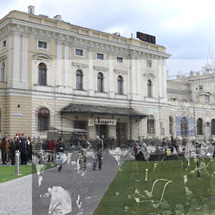Theories of capital
Rem Koolhaas has said that the spaces of the city are carved out by the flow of capital (imagine sculpting with a sand blaster), an acknowledgement of the importance of market forces in determining development decisions that is perhaps difficult to understand without having read the materialist critique of capitalism by Deleuze + Guattari. In these terms, how can a program of looking become instrumentalised and hence political, so that it is counter-productive in the sense that Deleuze + Guattari use this term: in the sense that it isother to the force of capital whose single aim is to perpetuate the cycle of production of capital, and whose effect is to flatten the differences between places. Amidst this monoculture of wealth creation, added value, investment opportunity, where every place is subjected to the equivalences and exchange value of the money system, we use looking to re-articulate the differences between places, memories, histories, and futures.
Theories of the city
Aldo Rossi's project in the Architecture of the City was to recuperate other forms of value for the city based on differences in topography, climate, history, habit, dreams, love. Rossi uses the theory of types to shift the focus from form and style (potential commodities) to meaning (he says type is not form). For Rossi, the city is haunted by meaning embedded in its built forms and their relationships and functions, which are recovered the only way meaning is ever recovered, by a kind of linguistic exercise he calls analogic thinking, but to which we could add metaphor, metonymy, free association, mistakes. He looks at how meaning coagulates around objects when we assign words to them; and how words become tangible when assigned to objects. He occupies the city by tarrying with the labyrinthine structure of visual narrative, and asks, not how much it is worth, but what it communicates.
These pages represent statements of other positions and other voices. They might also be forms of love and play. If we can sufficiently instrumentalise looking, it can become a platform for re-investing the market that shapes our city spaces with other values than exchange value.

